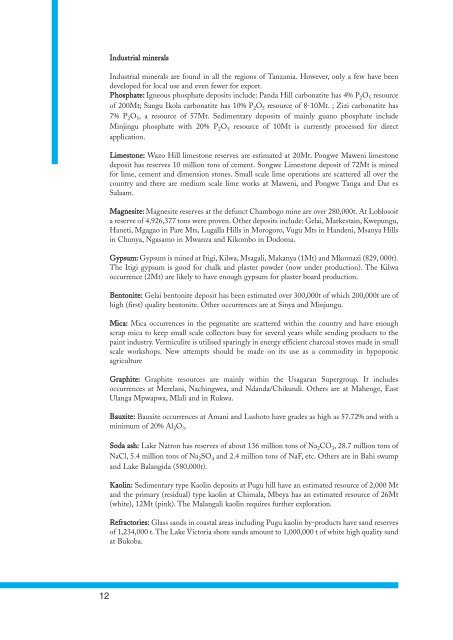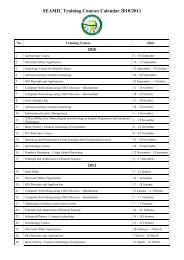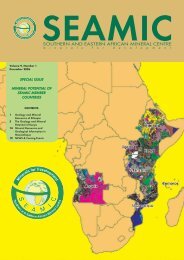SEAMIC Newsletter Vol. 10
SEAMIC Newsletter Vol. 10
SEAMIC Newsletter Vol. 10
You also want an ePaper? Increase the reach of your titles
YUMPU automatically turns print PDFs into web optimized ePapers that Google loves.
Industrial minerals<br />
Industrial minerals are found in all the regions of Tanzania. However, only a few have been<br />
developed for local use and even fewer for export.<br />
Phosphate: Igneous phosphate deposits include: Panda Hill carbonatite has 4% P 2 O 5 resource<br />
of 200Mt; Sangu Ikola carbonatite has <strong>10</strong>% P 2 O 5 resource of 8-<strong>10</strong>Mt. ; Zizi carbonatite has<br />
7% P 2 O 5 , a resource of 57Mt. Sedimentary deposits of mainly guano phosphate include<br />
Minjingu phosphate with 20% P 2 O 5 resource of <strong>10</strong>Mt is currently processed for direct<br />
application.<br />
Limestone: Wazo Hill limestone reserves are estimated at 20Mt. Pongwe Maweni limestone<br />
deposit has reserves <strong>10</strong> million tons of cement. Songwe Limestone deposit of 72Mt is mined<br />
for lime, cement and dimension stones. Small scale lime operations are scattered all over the<br />
country and there are medium scale lime works at Maweni, and Pongwe Tanga and Dar es<br />
Salaam.<br />
Magnesite: Magnesite reserves at the defunct Chambogo mine are over 280,000t. At Loblosoit<br />
a reserve of 4,926,377 tons were proven. Other deposits include: Gelai, Markestain, Kwepungu,<br />
Haneti, Mgagao in Pare Mts, Lugalla Hills in Morogoro, Vugu Mts in Handeni, Msanya Hills<br />
in Chunya, Ngasamo in Mwanza and Kikombo in Dodoma.<br />
Gypsum: Gypsum is mined at Itigi, Kilwa, Msagali, Makanya (1Mt) and Mkomazi (829, 000t).<br />
The Itigi gypsum is good for chalk and plaster powder (now under production). The Kilwa<br />
occurrence (2Mt) are likely to have enough gypsum for plaster board production.<br />
Bentonite: Gelai bentonite deposit has been estimated over 300,000t of which 200,000t are of<br />
high (first) quality bentonite. Other occurrences are at Sinya and Minjungu.<br />
Mica: Mica occurrences in the pegmatite are scattered within the country and have enough<br />
scrap mica to keep small scale collectors busy for several years while sending products to the<br />
paint industry. Vermiculite is utilised sparingly in energy efficient charcoal stoves made in small<br />
scale workshops. New attempts should be made on its use as a commodity in hypoponic<br />
agriculture<br />
Graphite: Graphite resources are mainly within the Usagaran Supergroup. It includes<br />
occurrences at Merelani, Nachingwea, and Ndanda/Chikundi. Others are at Mahenge, East<br />
Ulanga Mpwapwa, Mlali and in Rukwa.<br />
Bauxite: Bauxite occurrences at Amani and Lushoto have grades as high as 57.72% and with a<br />
minimum of 20% Al 2 O 3 .<br />
Soda ash: Lake Natron has reserves of about 136 million tons of Na 2 CO 3 , 28.7 million tons of<br />
NaCl, 5.4 million tons of Na 2 SO 4 and 2.4 million tons of NaF, etc. Others are in Bahi swamp<br />
and Lake Balangida (580,000t).<br />
Kaolin: Sedimentary type Kaolin deposits at Pugu hill have an estimated resource of 2,000 Mt<br />
and the primary (residual) type kaolin at Chimala, Mbeya has an estimated resource of 26Mt<br />
(white), 12Mt (pink). The Malangali kaolin requires further exploration.<br />
Refractories: Glass sands in coastal areas including Pugu kaolin by-products have sand reserves<br />
of 1,234,000 t. The Lake Victoria shore sands amount to 1,000,000 t of white high quality sand<br />
at Bukoba.<br />
12




